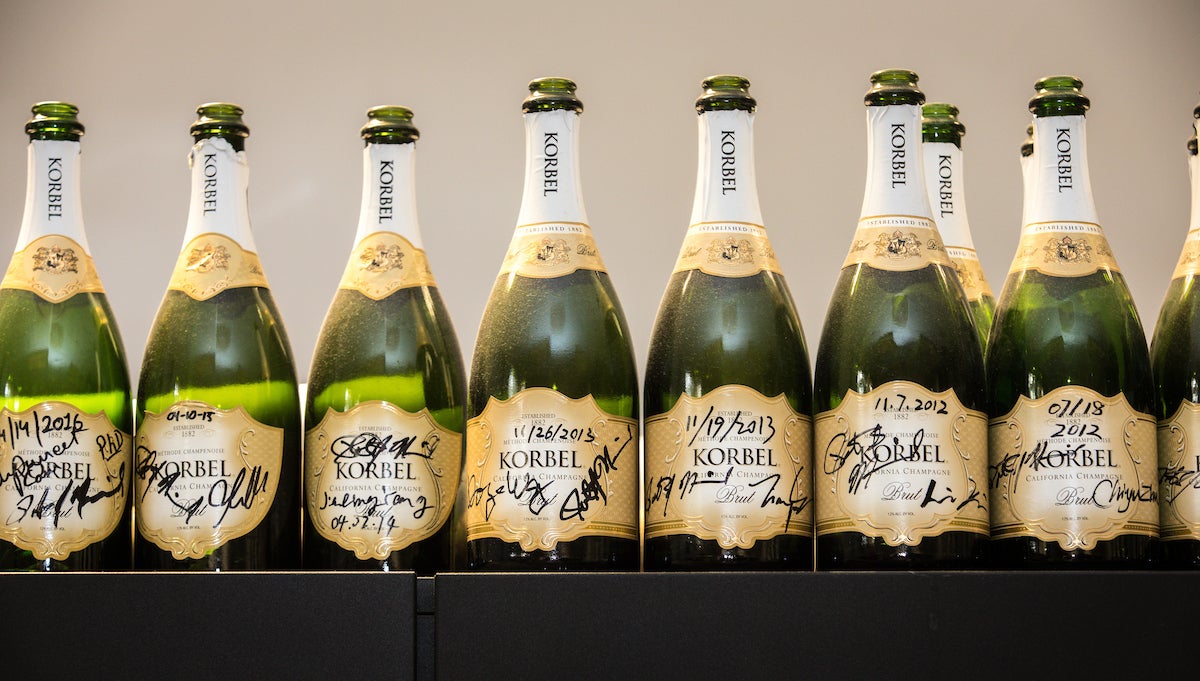ASU Physics Professor Robert Nemanich doesn’t have 99 bottles of beer on the wall; he has 75 bottles of champagne on the top of his desk.
It’s a tradition that comes from commencement whenever one of his graduate students gets their degree. So far he has seen 53 students receive their PhDs and 22 obtain their masters under his tutelage.
“It’s good to punctuate your life whenever there’s a big accomplishment,” Nemanich said. “If you don’t celebrate those victories, then it’s just another day.”
Recently, the university toasted Nemanich by naming him as one of threeASU scholars Anne Stone and Paul Westerhoff are the other two Regents’ Professors for 2016-2017. Regents' Professors for the 2016-17 academic year.
On shelves in the lab and his office, Regents' Professor Robert Nemanich saves the signed champagne bottle from each of his master's and doctoral graduates. Photo by Charlie Leight/ASU Now
Regents’ Professor is the highest faculty honor and is conferred on full professors who have made remarkable achievements that have brought them national attention and international distinction.
“Professor Nemanich is an outstanding classroom instructor and has also been a pioneer in the development of online courses,” said Peter A. Bennett, professor and chair in ASU’s Department of Physics. He added that another form of teaching is in the mentoring of research personnel and that “here Professor Nemanich also shines.”
That summation is fitting given that Nemanich’s work focuses on the creation and use of diamond wafers instead of silicon wafers for high-power electronics, providing improved efficiency and ability to function in high-temperature applications.
“These wafers are small, lightweight and conduct heat away rather than overheating,” Nemanich said. The diamond wafers can be used for high-power grids, electronic cars, jet engines and trains.
The electronics are made in an ASU lab by electrically conducting diamond layers on the wafers. The lab-grown diamonds are fabricated at high pressure, or by plasma growth as opposed to being mined in the ground. The materials could be coal or high-purity gas sources.
Nemanich’s research projects for diamond-powered transistors have totaled close to $3 million for ASU. He has also presented more than 200 invited lectures and published more than 400 research papers, which have been cited in scientific literature more than 22,000 times, according to the university.
“His pioneering contributions have had remarkable impact in interdisciplinary materials physics,” said ASU physics and Regents’ Professor David Smith. “His research is highly regarded at both national and international levels.”
Nemanich has served as president of the Materials Research Society, one of the largest scientific societies in this country, as well as president of the International Union of Materials Research Society.
He also had a highly distinguished record of service as physics department chair at ASU from 2006 to 2013.
Accolades aside, for Nemanich the great joy of his work is forging lasting relationships with his physics, electrical engineering and material science students.
“He seems to have an intuitive understanding how to help us be successful and tailors his own method of teaching and motivating to each of us,” said Brianna Eller, who received her PhD in physics from Nemanich in 2015. “I hope that I have learned how to be a better mentor as his student in addition to learning from his wealth of knowledge.”
Nemanich said a good portion of his knowledge comes from students.
“The game is who learns more from who?” Nemanich said. “I always ask my students at the end, ‘Did you learn more from me, or did I learn more from you?’
“I usually win.”
Top photo: Recently selected Regents' Professor Robert Nemanich is at the forefront of the developing technology of using diamond wafers instead of silicon wafers for high-power electronics, providing improved efficiency and ability to function in high-temperature applications. Photo by Charlie Leight/ASU Now
More Science and technology

ASU and Deca Technologies selected to lead $100M SHIELD USA project to strengthen U.S. semiconductor packaging capabilities
The National Institute of Standards and Technology — part of the U.S. Department of Commerce — announced today that it plans to award as much as $100 million to Arizona State University and Deca…

From food crops to cancer clinics: Lessons in extermination resistance
Just as crop-devouring insects evolve to resist pesticides, cancer cells can increase their lethality by developing resistance to treatment. In fact, most deaths from cancer are caused by the…

ASU professor wins NIH Director’s New Innovator Award for research linking gene function to brain structure
Life experiences alter us in many ways, including how we act and our mental and physical health. What we go through can even change how our genes work, how the instructions coded into our DNA are…

